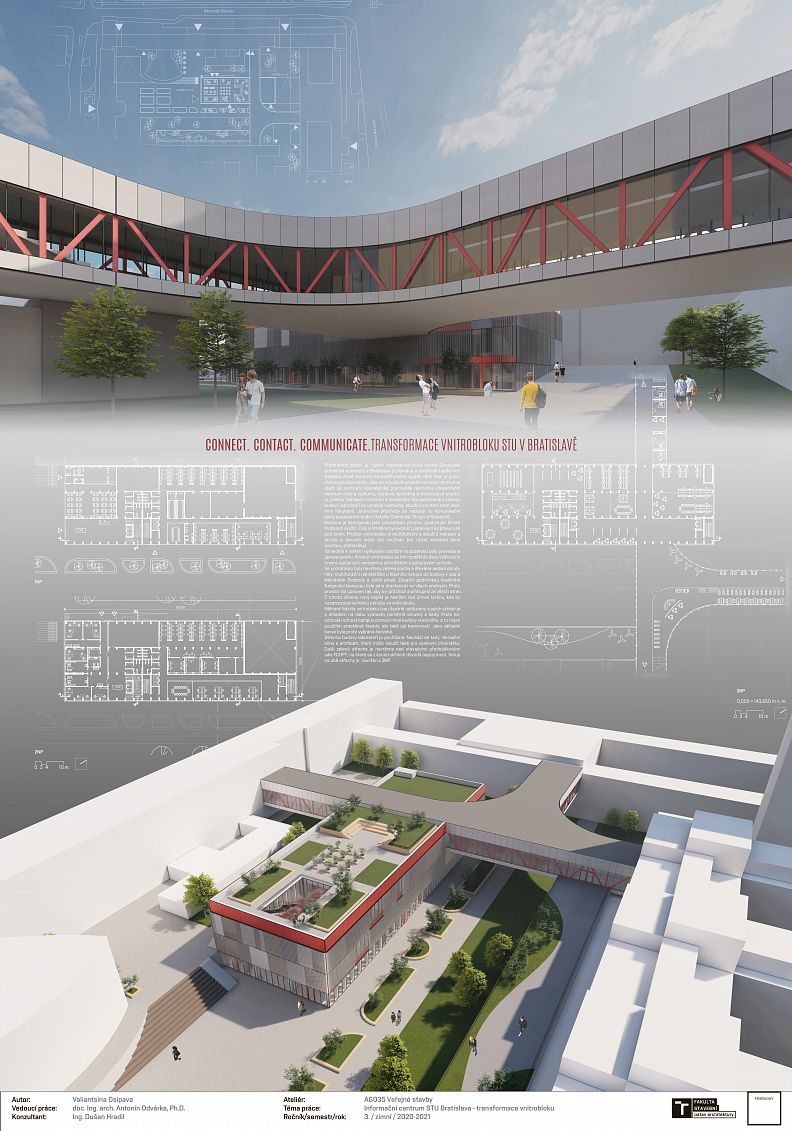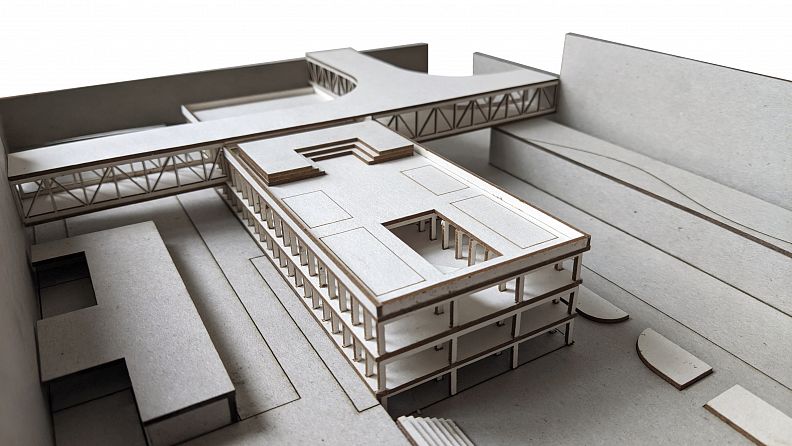Connect. Contact. Communicate. Transformation of the STU campus in Bratislava

Project idea
The name of the project - Connect. Contact. Communicate - describes the main idea, that lies in opening the space and putting everything in the campus together. The new building, that actually uses the skeleton of the old laboratory building, has connected existing faculties under the ground level. New innovation center has a big parking in underground floors, so at the same time the problem with parking is solved.
For better understanding of the concept I have prepared the schemes in the project portfolio.
Project description
DEFINITION AND PURPOSE OF THE BUILDING
The subject of the project was the design of the representative center of the Slovak University of Technology in Bratislava and the transformation and improvement of its courtyard, which currently includes many temporary buildings. There is also an old laboratory building, which the investor would prefer to save. The facades of this building are in poor condition, but its skeletal construction system is still strong and well-preserved, so it will allow the building to be reused after the reconstruction. Another reason to preserve the building is its convenient location in the middle of the courtyard, where it can be easily connected to other faculties. In my design I therefore decided to take this opportunity to preserve the construction of the building.
The new innovation center is multifunctional: most of it’s space is left for laboratories, the building also houses an innovation center and start-up center, Rectory's offices, a science and research presentation center, exhibition, common and multi-purpose spaces, a canteen, a fabrication center and a library.
A new superstructure was placed on the mentioned laboratory building, working as a bridge between the surrounding faculties. Crossings are connected to the communication spaces of neighboring buildings (faculties of Chemistry, Mechanical Engineering and Civil Engineering).
The campus is designed as a public space, providing a wide range of uses. The whole courtyard was opened, parking moved under the terrain. The courtyard space is used for recreation and study and can also be used for outdoor events (exhibitions, lectures).
URBANISTIC SOLUTION
The campus is located in the Old Town, which is the historical center of Bratislava. The solved courtyard is surrounded by the buildings of the STU faculties on all sides.
By removing the temporary buildings, shortening the laboratory building by 4 modules in the longitudinal direction and moving the parking under the ground, the opening of the courtyard space was reached, as well as the axial connection with the Freedom Square. Access from all sides is in this case an essential condition for the good functioning of the space, so the existing entrances and ways from the side streets will be unlocked, which will open the courtyard even more and let it functioning as a public space.
The entrances for supply are designed from Radlinského Street, as well as the entrance to the underground car park. In this case, it was preserved in its current form.
Due to the large height differences on the site, the terrain was modified. The space of the courtyard was thus divided into two height levels, connected by ramps and a staircase with sitting stairs.
Green areas and wooden benches, a multifunctional square in front of the main entrance to the building in line with Náměstí Svobody and a water feature were designed in the courtyard. The space inside is open and passable, from any side you can get to the designed object and to any other building.
ARCHITECTURAL SOLUTION
The new building consists of the skeleton of an existing laboratory building and a new superstructure on it, which on the third floor connects the surrounding buildings. This bridge has a "T" shape with rounded corners.
Some faculties of the courtyard are poorly maintained and their appearance is relatively sad and gray regarding to the time of construction. Therefore, there was a need to "light up" the campus with a new building, not only using a light coming through the glazed facade, but also using colors. Therefore, red was chosen as the main color, which is used on the parapet panels of the facade system in the laboratory building. In combination with white rotating shading slats, the glazed facade looks elegant and the red color does not hit in the eyes. The facade of the bridge is designed similarly, but there are no shading elements on it. On the contrary, the steel lattice system was moved in front of the glazed facade and highlighted with the same red color which is used on the panels of the main building. The rest of the facade is designed in white, which supports the color of the shading slats and helps to strengthen the impact of the supporting structure.
The roof of the laboratory building is walking. There is a recreation area and an amphitheater on it, which can also be used for outdoor lectures. Entry to the roof is possible from the 3rd floor.
Another green roof is designed on the existing FCFT lecture halls. The structure of these halls due to structural reasons will be used for supporting the bridge construction. The entrance to this roof is also designed from the 3rd floor of the new building.
SPATIAL SOLUTIONS
The new center consists of 3 floors above ground and 2 underground floors. The main entrance is designed from the new built multi-purpose square. The main hall can also be entered from the two-storey underground car park. The laboratories and the Rectory’s Offices have their own entrances.
The location of the innovation and start-up centers were not chosen randomly. These centers are located as close as possible to the existing innovation center, located somewhere between the faculties of Mechanical Engineering and Civil Engineering.
As it was already mentioned, the bridge in the 3rd floor is connected to the communication cores of neighboring buildings, which allows fast transitions between all buildings. Such possibility is especially important in case of bad weather: from the underground car park through the new building you can get to any faculty.
SPACE USAGE
Laboratories 2000 m2
Innovation and start-up center 1000 m2
Common, exhibition, multipurpose spaces 800 m2
Library, study rooms 680 m2
Administration, rectory 410 m2
Science and research presentation center 350 m2
Canteen 320 m2
Entrance zone, information 215 m2
Production center 160 m2
HVAC 130 m2
Technical information
The construction system of the building consists of the existing reinforced concrete skeleton of the old laboratory building and the steel truss structure of the bridge, which rests on the supporting skeletons of neighboring buildings. The skeleton of the main building consists of transverse reinforced concrete frames, consisting of columns and girders. The ceiling structure is made of ceiling reinforced concrete panels. Stiffening of the structure is provided by two communication cores, the walls of the hygienic core and the HVAC shaft. In the 1st and 2nd floors, additional rigidity is provided by the construction of a two-storey heavy laboratory.
The structural system of the underground car park is separated from the existing structural system, further expansion joints are designed in the transverse direction of both separate skeletons.
The massive lattice steel structure of the bridge connects the buildings of the campus. In the place of the largest span, this structure rests on the roof of the FCFT lecture halls, which significantly reduces the span. The floor and ceiling structures of the bridge are formed by a three-dimensional lattice structure.
The lightweight façade system FWS 50 is supplied by SCHUCO. It consists of glazed panels made of clear glass and window sill panels made of aluminum. This facade system has excellent thermal insulation properties.
Documentation
Show PDF 1Show PDF 2Show PDF 3Show PDF 4Show PDF 5Show PDF 6Show PDF 7Show PDF 8Show PDF 9Show PDF 10Show PDF 11Show PDF 12Show PDF 13Show PDF 14Show PDF 15Show PDF 16Show PDF 17Show PDF 18Show PDF 19Show PDF 20Show PDF 21Show PDF 22Show PDF 23Show PDF 24Show PDF 25Show PDF 26Show PDF 27Show PDF 28































